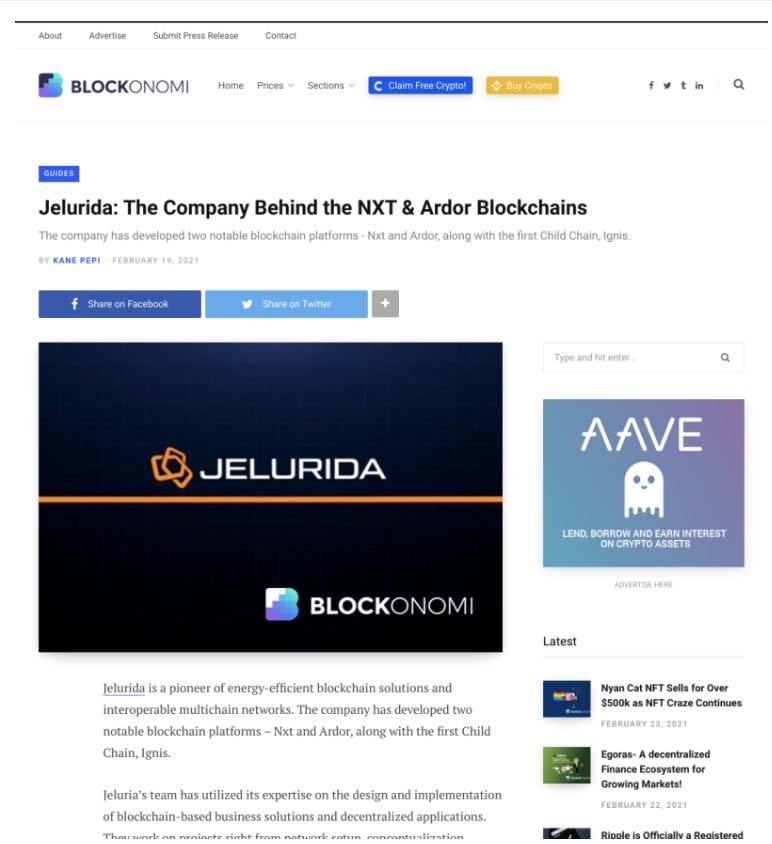Media Mentions
Simplex Ardor Addition Can Spur More Effective Blockchain Handling
IHold: Today, tech media outlets are talking about the addition of tools by fiat/crypto exchange Simplex related to the Ardor blockchain and attached Ignis and Nxt child chain protocols. What's so great about this winning combination? Essentially, Ardor's structure and child/parent setups drive more types of modern digital asset processes. Through that model, users will be able to benefit from the key functionality that the Ignis and Nxt chains provide, in an ecosystem that shows off the power of open source systems to innovate in DeFi. All of that rests on the previous work of the Jelurida company that began in 2016 in the Netherlands, and now operates in various countries around the world. Jelurida maintains both Ardor and Nxt and helps to provide stability for this sector of the fintech marketplace.
March 02, 2021


Tarasca DAO - Could This Be the First DAO with Mass Appeal?
U.Today: Tarasca DAO has chosen to set up on the Ardor blockchain for several reasons. Ardor is a parent-and-child chain structure, with Ardor operating as the parent chain, securing multiple child chains. One of the child chains is Ignis, Ardor’s main child chain. Between Ardor and Ignis, Tarasca has access to several out-of-the-box features that support setting up a DAO. These include a voting system, a messaging system, and a means for dividend distribution, among others. Furthermore, Ardor offers a more secure DAO environment than Ethereum, as these features are already in place and tested by Jelurida, the company that operates Ardor. On Ethereum, developers are required to program all the features of their DAO from scratch. Doing so creates an opportunity for bugs and vulnerabilities to creep into the code.
March 01, 2021
Jelurida Africaがナイジェリアの仮想通貨サービス禁止令にコメント
CoinPost: ジェルリダ・アフリカとは、アーダーブロックチェーン開発などで知られる、スイスのブロックチェーン開発企業ジェルリダのアフリカ支部だ。分散型台帳技術普及およびスマートコントラクトの専門家で構成され、アフリカでのブロックチェーン技術促進をミッションに、コンサルティング、教育およびプロダクト開発支援など、幅広い分野で活動している。
このような活動の一環として、ジェルリダ・アフリカは、アフリカ拠点の起業家や開発者の育成を目的としたABDC(Africa Blockchain Dev Call)プログラムを開催。3月には、「タンザニア・ブロックチェーン・ミートアップ 」と題した、教育目的のミートアップを主催する予定だ。
ジェルリダの共同創設者Lior Yaffe氏曰く、ジェルリダがアフリカに拠点を置き、アフリカ基盤のプロジェクトをサポートしているのは、同地域の金融サービスの少なさ、および透明性への需要増加が理由だという。このようなケースは、分散型台帳技術の最適なユースケースであると、同氏は述べている。
February 27, 2021


Nigeria – The people fight back against central bank cryptocurrency limitations
Bitcoinist.com: Around the African continent, the use of new digital currencies and fintech solutions is expanding, as a common interest in decentralized finance grows. One example is at Jelurida Africa, where a recent Africa Blockchain Developer Call Series program promoted more entrepreneurs and engineers getting involved in the cryptocurrency world. Jelurida Africa is an offshoot of a Swiss firm of the same name, which was incorporated in the Netherlands in 2016 and moved to Switzerland in 2017. Now, Jelurida Africa is engaged in prelaunch project testing and other goals ahead of additional expansion to a greater number of African nations. At the same time, Jelurida Africa Managing Director Adedayo Adebajo is addressing the Nigerian bank’s notice by noting the conflict between fiat and crypto systems. “My question is, will the CBN reinstate the cryptocurrency support if the fundraising is carried out in support of the sitting government?” Adebajo said, according to reporting at Bitcoin.com. “Situations like this provide more reasons why decentralization, as offered by the blockchain technology, is highly required in Africa.”
February 22, 2021
Nigerian Crypto Shut-Out Won’t Depress New Defi And Digital Asset Banking
BTC Manager: Now there are new fintech and cryptocurrency initiatives on the horizon that are generating their own interest and attention worldwide. For example, a firm called Jelurida Africa is trading on the success of its Africa Blockchain Developer Call Series and building a bigger footprint for eventual rollout in more African countries.
What is Jelurida Africa? According to its web site, the enterprise “offer(s) guides to startups and established businesses both ones that have adopted the technology and the prospects which can be in multiple stages” and “engage(s) in practical and training for staffs in the organization or institutions on the new technology, how it’s being used and the benefits it offers for their company processes.”
It’s part of a movement to make cryptocurrencies and decentralized finance assets more a part of the financial webwork, not less, and to allow different financial ecosystems to coexist better together. As Jelurida Africa Managing Director Adebayo Adebajo says of Nigeria’s CBN and its recent mandate
February 22, 2021


Jelurida: The Company Behind the NXT & Ardor Blockchains
Blockonomy: Jelurida is a pioneer of energy-efficient blockchain solutions and interoperable multichain networks. The company has developed two notable blockchain platforms – Nxt and Ardor, along with the first Child Chain, Ignis. Jeluria’s team has utilized its expertise on the design and implementation of blockchain-based business solutions and decentralized applications. They work on projects right from network setup, conceptualization, development, and maintenance. This article explores the ins and outs of Jelurida and what the platform offers.
Nxt is considered the first blockchain to be built entirely based on a proof-of-stake consensus protocol.
Ardor is a multichain blockchain platform is built on a unique parent-child chain architecture. The parent Ardor chain is responsible for safekeeping the entire network, whereas the interoperable child chain is loaded with rich functionalities.
February 19, 2021